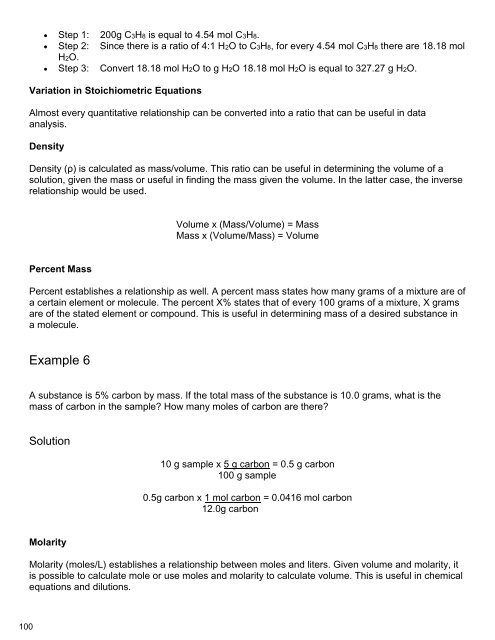Create successful ePaper yourself
Turn your PDF publications into a flip-book with our unique Google optimized e-Paper software.
Step 1: 200g C3H8 is equal to 4.54 mol C3H8.<br />
Step 2: Since there is a ratio of 4:1 H2O to C3H8, for every 4.54 mol C3H8 there are 18.18 mol<br />
H2O.<br />
Step 3: Convert 18.18 mol H2O to g H2O 18.18 mol H2O is equal to 327.27 g H2O.<br />
Variation in Stoichiometric Equations<br />
Almost every quantitative relationship can be converted into a ratio that can be useful in data<br />
analysis.<br />
Density<br />
Density (ρ) is calculated as mass/volume. This ratio can be useful in determining the volume of a<br />
solution, given the mass or useful in finding the mass given the volume. In the latter case, the inverse<br />
relationship would be used.<br />
Volume x (Mass/Volume) = Mass<br />
Mass x (Volume/Mass) = Volume<br />
Percent Mass<br />
Percent establishes a relationship as well. A percent mass states how many grams of a mixture are of<br />
a certain element or molecule. The percent X% states that of every 100 grams of a mixture, X grams<br />
are of the stated element or compound. This is useful in determining mass of a desired substance in<br />
a molecule.<br />
Example 6<br />
A substance is 5% carbon by mass. If the total mass of the substance is 10.0 grams, what is the<br />
mass of carbon in the sample? How many moles of carbon are there?<br />
Solution<br />
10 g sample x 5 g carbon = 0.5 g carbon<br />
100 g sample<br />
0.5g carbon x 1 mol carbon = 0.0416 mol carbon<br />
12.0g carbon<br />
Molarity<br />
Molarity (moles/L) establishes a relationship between moles and liters. Given volume and molarity, it<br />
is possible to calculate mole or use moles and molarity to calculate volume. This is useful in chemical<br />
equations and dilutions.<br />
100



